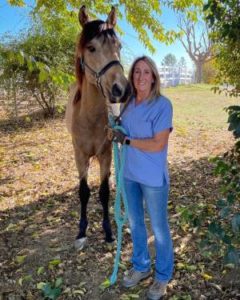
GIVING YOUR HORSE ORAL MED …
The most important part of any treatment is seeing that your horse or foal gets the total dose at the prescribed time for the total number of days as directed. Oral medications come in tablet, drench solution, paste, powder and granule forms.
Tablets may be given by balling gun, especially larger tablets (boluses), or several small tablets can be wrapped together in a small piece of paper towel for a single administration. Place the balling gun in the corner of the horse’s mouth, gently push the balling gun tip to the back of the tongue as you raise the horse’s head, and dispense. Watch to see
if the horse swallows the medication or if the tablets come back out of the mouth.
Many tablets are so small that they can be mixed with the feed without crushing. Larger tablets or boluses can be crushed with a mortar and pestle, or a hammer can be used to crush the tablets wrapped in a small plastic bag. Mix the powdered tablets into the horse’s feed, as described below for powders.
Powders or granules should be mixed directly with the feed. Dampening the feed with molasses makes the mixture more palatable for your horse and keeps powders, granules and small tablets from separating out. Check the bottom of the feed bucket 15-30minutes after feeding to make sure the entire mixture has been eaten.
Some injectable solutions can be given orally. This is an “off-label” (unapproved) use of these drugs, but it is sometirnes done with certaininjectable solutions and clinical situations. Never use injectable drugs in this way unless instructed by your veterinarian.
Drenches are less commonly used in horses today than previously. During drenching, be sure all of the drench is swallowed, rather thanslopped out of the horse’s mouth.
When giving a paste medication, place the tip of the paste syringe in the corner of your horse’s mouth, elevate its head slightly, move the syringe tip backward and forward about 1 inch to stimulate movelnent of the tongue, and inject the medication. For horses that tend to spit out the medication, continue moving the syringe tip back and forth while the head is elevated. Swallowing is less important than getting the tongue to move. Tongue movement causes the paste to stick to the tongue and the gums, ensuring that the medication will eventually be swallowed.
Some tablets can be administered as a paste, particularly those that readily dissolve in water. These tablets can be rnixed with a small amount of water in a dose syringe to form a paste. Add a few teaspoons of molasses to these dissolved tablets and administer as you would a paste.

















